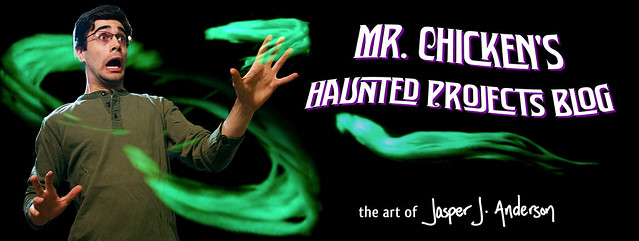Good evening.
I’m Mr. Chicken, and you’re entering my Hall of Illusions. This time we’re going to talk about how
to get the best results out of one of the cheapest and easiest to find
sculpting mediums out there—Crayola Model Magic.
As I mentioned in the last episode, the big advantage of air
dry clays for is that your sculpture is your final product. You don’t need to mold and cast to get
a usable prop.
I used model magic for the heads of most of the characters
in my haunt. Here’s what I found
worked best for me. I’d pick
something to use as an armature. A
skull or modified foam wighead work well.
To modify a wighead for use as an armature, cut off the nose and lips,
and carve down the sides of the head a bit so you won’t be forced to follow the
proportions of those things. Wrap
the armature in aluminum foil before sculpting—more on that later.
Then you just want to tear off pieces of clay, form them
into approximately the right shape for the facial feature you’re working on,
and apply it to the form. You want
to work in this way, rather than trying to mush around large pieces, because
the model magic has a strange elastic quality that makes it difficult to
reshape, so try to get your forms as close as you can when you first lay them down. A blob for the nose, blobs for the cheeks and chin, you get
the idea. Water will help smooth
and blend between these blobs, as will very thin pieces of clay from time to
time. Plastic balls cut in half
make good eyes.
When you’re ready for details like wrinkles, take your tool
and wet it first so it will glide over the clay and not stick to it. Unlike more professional clays, the
model magic doesn’t like to be refined gradually. It’s more about picking a shape and sticking with it. This means that you’ll often end up
with a face that doesn’t quite match your original plan, but that’s part of the
fun.
If you need to walk away from your sculpture for the day,
just spritz it with a little water and put a plastic bag over it.
In my experience, air dry clays will crack if one side dries
out faster than the other. The Crayola air dry clays (Model Magic, and pretty
much any air dry clay out there, as far as I know) are water based. The water
needs to evaporate from the clay in order for it to harden. Now, as the water
evaporates, the clay loses mass and shrinks. However, if something (such as the
armature you’re sculpting on, be it a skull, foam head, or wad of newspaper)
prevents the water from escaping evenly, one side (the face) will dry faster
than the other (the inside). This means that the outside is shrinking faster
than the inside, so it cracks.
When I make heads in air dry clay, I cover my armature
(either a skull or foam wig head) in aluminum foil so that as soon as the face
is dry to the touch, I can remove it from the armature, peel off the foil, and
allow the sculpture to dry thoroughly.
I do this by slicing the sculpture from ear to ear with an xacto blade,
and pulling the two halves apart.
Shortly thereafter, I give the whole thing a coat of latex-based
paint, just in case, to hold the surface together should any cracking be
tempted to ensue. You need a base
coat anyway. I like to paint the
rest in washes and drybrushing with cheap acrylic paints.
To attach it to a body, I shoot a bit of great stuff in the
head...just enough to grab the PVC that makes up the neck.
That’s what’s worked for me in the past. If you have any questions, suggestions,
or tips of your own to share, let me know at chickenhaunt [at] gmail.com.

